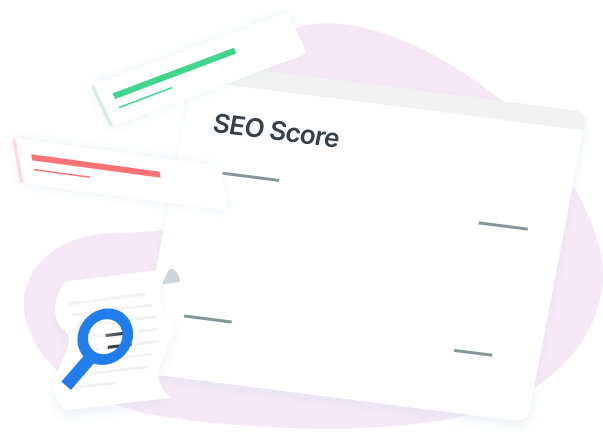Web Design and SEO: How to Optimize Your Website Design for Top Rankings
Does your business want to rank on the first page of search results? Then you need to learn about web design and search engine optimization (SEO), a critical duo in SEO.
When you create a site that nails SEO and website design, you make it possible for your business to rank higher in search results, which translates to more traffic, leads, and revenue.
On this page, we’re exploring all things SEO website design to help you craft a site that drives traffic and leads for your business.
Let’s get started!
Looking for an all-in-one SEO audit tool? You've found it.
SEO Checker provides data on key metrics to give you:
- Complete SEO score
- Content Grade
- Site Speed Analysis
- and more.

What is SEO web design?
SEO web design refers to designing and developing SEO-friendly websites. An SEO-friendly website follows SEO best practices, like providing a mobile-friendly experience, fast load times, and descriptive URLs. By practicing SEO website design, businesses make it easier for search engines to understand and rank that company’s website in search results, which can lead to increases in rankings and traffic.
Why is SEO web design important?
So, why is SEO website important? How does it impact your business?
Together, the two can have a tremendous impact on your company’s bottom line. That’s why, if you’re thinking about having a site designed or redesigned, it’s vital to know why website design and SEO are important — and what that means for your site.
SEO web design matters because:
Web design can erase or damage your SEO
Many companies will launch a brand-new site — or rebrand to a new domain name — and see their SEO progress disappear overnight because they forgot to set up 301 redirects. A 301 redirect tells search engines where to find a relocated page.
SEO can influence your web design
When you consider SEO best practices that relate to web design, like page speed optimization, voice search, and site architecture, you’ll often find these factors directly influence how you design your site. Skip SEO, and you’ll struggle to rank where you want.
If you skip SEO website design, you’ll often cost your business time, money, and rankings. It’s smarter to incorporate SEO and web design together because you can build a foundation for your SEO strategy via your website and its design.
8 factors to optimize for web design and SEO
Now that you understand the link between web design and SEO, let’s take a look at the specific aspects of your site that are affected by both and how you can optimize them for SEO website design.
Here are eight factors to consider when creating an optimized SEO website:
1. Code
Designers have a few options when it comes to the code they use to render the major design elements of your site. Most stick to HTML and CSS, and for good reason.
While Flash sites may look cool, they are extremely difficult to optimize, and as a result, they don’t have great chances of ranking well in search engines. Tell your designer to stay away from Flash, and your SEO will thank you.
2. Mobile-friendliness
An increasing amount of Internet users browse sites on smartphones and other mobile devices, and your site needs to be accessible to all of them. Not only will this provide a better user experience, but it will also help your chances of ranking well now that mobile-friendliness is a ranking factor for Google.
The best way to address this is with responsive design, which makes your site accessible on all devices and browsers. Responsive design also eliminates the potential for duplicate content, which can happen if you have a separate mobile site.
3. Readability
While designers may primarily focus on the non-text elements of your site, it’s important that they choose fonts and sizes that are easy for your visitors to read.
Also, unless the body copy is being pulled from an existing site (or has been pre-written) and is included with your design specs, your designer should know to leave plenty of space for copy. You’ll need lots of informative, optimized content in order to rank well, and a design that only looks good with a few sentences of text will frustrate your SEO.
4. File names
Your images should all have descriptive, logical file names. Although it may require a little more work than simply leaving them with names like “IMG_0035.jpg”, this will help search engines “see” your images and put them into context.
5. File size
Although large, high quality images are certainly visually appealing, your designer should try to keep file sizes as small as possible. Large files can slow down page load times, which not only provides a poor user experience, but also increases your bounce rate—and damages your rankings.
6. Alt tags
In addition to their file names, your images should also have optimized alt tags. These descriptions help search engines determine what is being depicted, and users can read it when they mouse over an image.
Alt tags also help visually impaired users (and users whose browsers do not support your files) understand what is being shown, which is important for accessibility reasons.
7. Navigation
Navigation is one of the most important components of a great user experience, and because of that, you should keep it simple. The easier it is for your site visitors to find what they need, the more likely they’ll be to convert.
Easy-to-use navigation also lowers the chances that your visitors will get confused and leave your site, which can lower your bounce rate and improve your rankings.
8. URL structure
Each of your pages should have a descriptive URL that describes the content on the page. Words should be divided by hyphens (NOT underscores), and you can include a few relevant keywords.
URLs with descriptive words (as opposed to random numbers and letters) will help search engines understand your pages, and they will also be easier for your site visitors to remember.
FAQs about web design and SEO
Get answers to common questions about web design and SEO in this FAQ!
How are web design and SEO related?
Ultimately, the goal of both web design and SEO is to provide users with a great experience. So while designers focus more on the aesthetic components of a site and SEOs focus more on the aspects that help it rank well in search engines, the desired result is the same: A site that gives visitors what they want and helps your business succeed.
In order to provide your visitors with the information they need to become customers, your site needs to be both functional and visually appealing — two qualities that a good designer should be able to achieve. It also needs to be easy for potential customers to find, which is the responsibility of an SEO.
Is website design or SEO more important?
Many site owners think that great design can outweigh bad SEO, or vice versa, and want to know which is more important. However, the answer is neither. To put it simply, strong SEO is what draws users to your site, and great design is what keeps them there.
Having a site that is beautiful is useless if no one sees it, and having a site that ranks at the top of search engines won’t help you if your poor design makes visitors leave (which, in turn, will hurt your rankings).
How to practice SEO web design in your business
Because web design and SEO are so closely related, you need to make sure that they work well with one another. That’s why the all-too-common process of hiring a designer to lay out and create a site, then bringing in an SEO as an afterthought should be avoided at all costs.
Both a designer and SEO should be involved the early stages of your project. This will help the designer create a site architecture that is SEO-friendly, and will also provide an opportunity for your SEO to see the intricacies of your site design.
You may think that the best way to ensure that your design and optimization work well together is to hire one individual who does both web design and SEO — but if that’s what you’re considering, be very careful. Those are two distinct fields, and it’s better to hire separate people who are great at each than one person who is mediocre at both.
A better solution is to hire a full-service Internet marketing agency. By allowing an established team of designers, developers, and SEOs to work together on your site, you can be sure not only that the final result will be cohesive, but that each aspect was done by a specialized professional.
Make web design and SEO a success for your site
The relationship between web design and SEO is a complex one, but we hope that this page helped make it a little clearer. If you have any questions about how your site does at combining the two, or if you are considering starting a design or redesign project, WebFX can help.
Our SEO web design company’s talented team of designers, developers, and SEOs is more than happy to assist you in creating a site that is both functional and visually appealing. We’ve produced more than 1,600 sites, and have helped our clients earn over $6 billion in revenue in the past five years!
Contact us online or give us a ring at 888-601-5359 to learn more about our SEO plans and website design services!
Related Resources
- Types of SEO
- User-Friendly SEO
- UX and SEO
- Ways to Keep Website Visitors Coming Back
- Website Optimization Checklist: Your Go-To Guide to SEO
- What Are Different Types of SEO? 5 Types to Consider Using
- What Are Google Penalties and What Do They Mean?
- What Are Vanity URLs, and How Do You Create One?
- What Happens when You Stop SEO?
- What to Look for in a Good SEO Report
Marketing Tips for Niche Industries
- Top-of-the-Line SEO Services for Health Insurance Companies
- Tourism SEO: 3 Tips for Getting Started
- Unlocking Success: Long Tail Keywords for Dentists
- Urgent Care SEO & SEO Services
- Why Long-Tail Keywords Are Important for Electricians
- Why SEO for Museums Matters
- Why SEO is Important for Medical Equipment Companies
- Why Your Grocery Store Needs SEO
- 10 Easy Ways to Boost SEO for Yoga Studios
- 10 Ways Retailers Can Build Links for Their Websites


How Is Your Website's SEO?
Use our free tool to get your score calculated in under 60 seconds.







